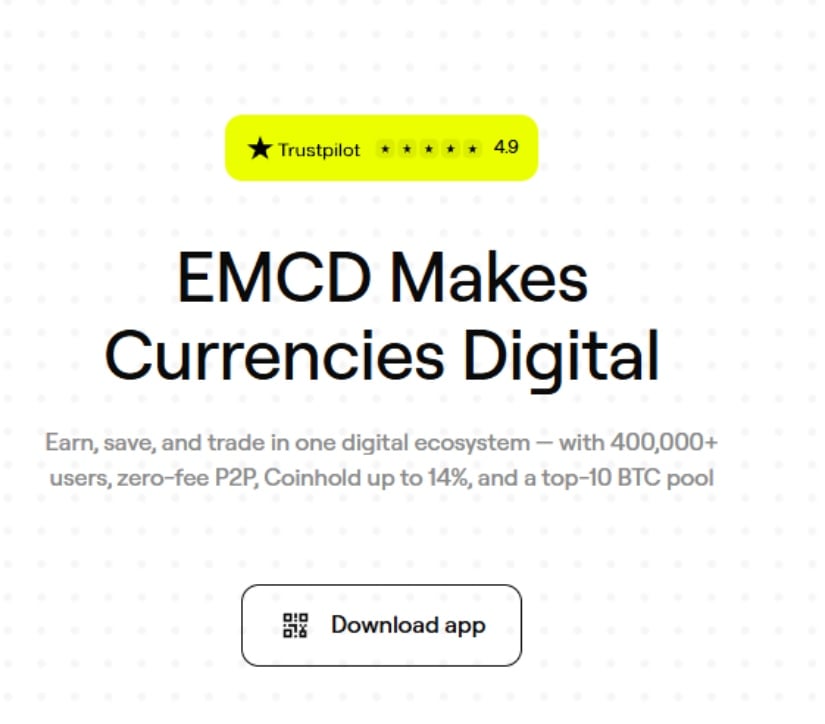
Stabull Finance emerges to meet this need as a “fourth-generation” automated market maker (AMM) designed specifically for stablecoin and commodity swaps. B
Building on innovations from earlier AMMs like Uniswap, Curve, and DFX, Stabull introduces a proactive, oracle-driven liquidity model that minimizes slippage and impermanent loss for assets whose true price is determined most accurately off-chain
By concentrating liquidity around external price feeds and mitigating the pitfalls of prior DEX designs, Stabull aims to serve as critical infrastructure for on-chain foreign exchange and commodity trading.
The integration with European Web2.5 platform EMCD.io – a large crypto-finance ecosystem with fiat on/off ramps and 400,000+ KYC’d users – underscores Stabull’s role as a bridge between DeFi and mainstream finance, bringing stable asset liquidity to a broader user base.
In this article, we delve into Stabull’s smart contract architecture and liquidity mechanisms in depth, examining how its bonding curves, LVR model, and oracle safeguards work together to enable low-slippage swaps for stablecoins and tokenized commodities. We also explore the significance of Stabull’s listing on EMCD.io and why such DeFi-to-Web2.5 bridges are vital for real-world adoption of stable assets.
Stabull positions itself as a fourth-generation AMM that builds upon the lessons of earlier decentralized exchanges. The first generation of AMMs (exemplified by Uniswap V1/V2) introduced the constant-product formula x·y = k, spreading liquidity across all prices equally. This provided a simple, permissionless trading model but was capital-inefficient for assets with predictable price ranges.
Second-generation protocols like Curve optimized for low-slippage swaps between pegged assets (e.g. two USD stablecoins) by using a modified invariant that creates a flat pricing curve around 1:1. However, when faced with assets that are not strictly pegged (such as a EUR stablecoin vs USD stablecoin), these models struggled – they either suffered from stale pricing or had to “re-peg” periodically using oracles. \
Third-generation AMMs brought further advancements. Uniswap V3 introduced concentrated liquidity, allowing liquidity providers (LPs) to focus their capital within a chosen price range for greater efficiency.
Other projects like DFX Finance targeted forex stablecoin pairs, employing custom bonding curves with unique parameters (often called beta and delta) to create a wide zero-slippage zone around the target exchange rate.
DFX also incorporated periodic oracle adjustments to shift that zone as the real FX rate moved. These Gen-3 innovations addressed some limitations of earlier AMMs but introduced new complexities – for example, DFX’s wide flat region minimized slippage for small trades but could lead to large jumps at its edges, and pools often sat at the boundary of the no-slippage zone waiting for arbitrage.
Stabull Finance synthesizes these past insights into a Gen-4 AMM tailored for stable assets and RWAs. It integrates the concentrated liquidity concept of Uniswap V3 with a modified bonding curve akin to DFX’s, while actively anchoring prices to off-chain oracles. The result is a hybrid model that maximizes capital efficiency for assets with semi-stable or externally-pegged values.
Liquidity is not spread across the entire price spectrum or locked in an overly flat curve; instead, Stabull dynamically concentrates liquidity around an oracle-fed reference price, adjusting continuously as the external price evolves.
By doing so, Stabull can offer deep liquidity and low slippage near the true market rate, without relying solely on arbitrageurs to correct mispricing. This proactive approach marks a departure from earlier AMMs that passively waited for arbitrage to align on-chain prices with off-chain reality. Stabull’s core contributors describe it as “a 24/7 decentralized venue for stablecoins and tokenized RWAs” that builds on the foundations of Uniswap, Curve, and DFX to create a more efficient and inclusive DeFi.

Total Supply: $STABUL has a fixed maximum supply of 10 million tokens (ERC-20 standard). Unlike inflationary models, this cap means no new tokens will be minted beyond the initial allocation, ensuring the token supply remains fixed once fully released.
$STABUL is fundamentally a governance token for the Stabull Finance protocol, designed not as a passive investment but as a utility to steer the platform. Holding STABUL confers voting rights that allow participants to influence key protocol parameters and decisions. In particular, STABUL’s utility is centered around governance, liquidity incentives, and alignment of interests in the Stabull ecosystem:
Governance Rights: STABUL holders will govern the protocol via a DAO structure as Stabull progressively decentralizes control. Token holders can vote on proposals that affect protocol parameters and upgrades.
Gauge Voting for Liquidity Mining: One of STABUL’s most critical utilities is directing liquidity mining incentives to different liquidity pools, much like Curve’s gauge voting mechanism with veCRV. Stabull’s DEX supports multiple stablecoin and RWA trading pools across chains, and the STABUL token gives holders a say in how the 3,000,000 STABUL liquidity mining rewards are allocated among these pools.
Voting on Fee Parameters and Distribution: Beyond just liquidity mining weights, STABUL governance will extend to control protocol fee distribution and other economic parameters. The Stabull team has indicated that once the governance portal/DAO launches (expected in 2025), token holders will be empowered to vote quarterly on how protocol fees are allocated and on the emission rates for liquidity mining pools.
Protocol Fee Revenue Sharing: A standout aspect of Stabull’s tokenomics is how it recycles protocol revenue (trading fees) back into rewards, effectively creating an ongoing yield stream for participants without inflating the token supply. Stabull charges a modest 0.15% swap fee on every trade. Instead of simply distributing these fees directly to LPs in kind, Stabull uses them in a buyback-and-distribute model.
It is roughly approximated that 95% of fees go toward buying back STABUL. This ensures that nearly all of the DEX’s revenue directly or indirectly benefits STABUL holders and liquidity providers, aligning the growth of the platform with the growth in token value.
Stabull is a multi-chain protocol from the ground up – it initially launched on Ethereum and Polygon, and later expanded to Base (Coinbase’s L2). The $STABUL token is available natively on all three networks. Instead of separate token instances, Stabull uses Chainlink’s Cross-Chain Interoperability Protocol (CCIP) to maintain a single unified supply across networks. This is implemented via a burn-and-mint bridge model.
EMCD is a well-established crypto-financial platform known primarily as one of the world’s top Bitcoin mining pools, but it has evolved into a comprehensive app offering wallet services, trading, and yield products with a strong user base in Europe and globally.

As of 2025, EMCD boasts over 400,000 registered users and a robust infrastructure, including fiat gateways and compliance (AML/KYC) measures. By integrating with EMCD, Stabull effectively plugs into a large network of KYC-verified users who can seamlessly access stablecoins through fiat on-ramps.
EMCD has listed the $STABUL token on their exchange. EMCD’s platform which already supports zero-fee P2P crypto-to-fiat exchanges and interest-bearing “Coinhold” accounts paying up to 14% APY on stablecoins.
An EMCD can acquire the STABUL token and use it to their benefit. They can take their STABUL and use it on the Stabull platform for a variety of reasons.STABUL holders will be able to vote on which Sgtabull pools receive emissions. If you’re an EMCD user who prefers EUR-based stablecoins (e.g. EURS/USDC, EURC/USDT), you can vote to direct rewards toward those pools — improving liquidity, execution, and LP yields.
STABUL holders are also entitled to a share of the trading fees generated by the AMM Oracle fees, if applicable, and potential bribes and third-party incentives. The Stabull model aligns with ones used by Balancer, Convex, and others — where governance tokens capture real economic flow as yield.
This is also the beginning of a partnership that could become deeper and more powerful. We envision — A STABUL European user on EMCD depositing Euros via bank transfer, receiving EURS stablecoins in their EMCD wallet, and with a few clicks swap EURS to USDC or to another currency stablecoin through Stabull’s liquidity – all within the EMCD interface.
The user doesn’t need to directly interact with Metamask or know how Stabull’s contracts work; EMCD likely abstracts that away, giving a smooth Web2-style experience. Yet, behind the scenes, that trade is routed to Stabull’s decentralized pools.
This is the DeFi-to-Web2.5 bridge in action: the user benefits from decentralized liquidity and pricing (better rates, 24/7 availability, transparency) without leaving a familiar CeFi environment. For Stabull, this integration drives volume and liquidity that it might not attract on its own from retail users who are shy about self-custody or DeFi UIs.
The fiat on/off-ramp capability of EMCD is particularly significant. One of the barriers for non-USD stablecoins has been getting into them – you typically need to already have crypto, then find a DEX, etc. EMCD allows users to go from fiat to crypto stablecoin in one app. \
A Brazilian user, for instance, could use EMCD’s P2P to convert Brazilian Real in their bank to BRZ stablecoins, then use Stabull (via EMCD) to swap BRZ to USD stablecoins or others. This ease of entry and exit (since EMCD likewise can off-ramp to bank accounts or cards) makes the stablecoin FX use-case far more practical. Moreover, EMCD’s emphasis on security (audited, 2FA, etc.) and compliance gives institutional or conservative users confidence to participate.
An institutional investor in Europe might be hesitant to directly provide liquidity on a DeFi platform due to custody and regulatory concerns, but through a regulated intermediary like EMCD, they could deposit funds and allocate them into Stabull’s pools with the assurance of KYC and oversight. Essentially, EMCD serves as a gateway for traditional money into Stabull’s pools.
This collaboration underscores why bridging to Web2.5 platforms matters for stable asset liquidity. As advanced as Stabull’s tech is, its impact grows exponentially when connected to large user pools and fiat pipelines. Stabull on its own provides the rails for decentralized FX; EMCD provides the passengers and freight to run on those rails.
With the upcoming launch of the EMCD Card — a crypto-linked payment card usable at any Visa or Mastercard merchant — EMCD is removing one of the final barriers between digital assets and real-world utility.
This development significantly enhances the relevance of the Stabull partnership. As Stabull specializes in stablecoin and commodity swaps through an efficient, capital-optimized AMM, it enables users to access predictable, low-volatility digital assets like USD- or EUR-denominated stablecoins. These assets are ideal for everyday spending via EMCD’s card, offering a seamless transition from DeFi-native yield generation to frictionless fiat-like usability. Together, Stabull and EMCD create an end-to-end pipeline connecting DeFi to traditional payments.
Stabull’s collaboration with platforms like EMCD.io signals that DeFi infrastructure is maturing to the point of integration with established financial services. This confluence could unlock massive liquidity as everyday users and companies begin tapping into on-chain FX markets for practical needs, often without realizing it. Stabull’s listing on EMCD brings the protocol a ready audience of hundreds of thousands of users and a stamp of legitimacy in a regulated context
In a broader sense, it showcases a path forward for DeFi projects aiming for mass adoption: innovate at the protocol level, then connect with user-focused platforms to deliver those innovations to a wide market.
Also read: XRP Price Prediction: Can XRP Break the $4 Mark as Rex-Osprey Spot XRP ETF Goes Live?